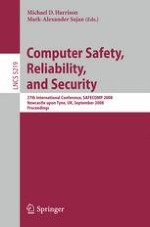2008 | Buch
Computer Safety, Reliability, and Security
27th International Conference, SAFECOMP 2008 Newcastle upon Tyne, UK, September 22-25, 2008 Proceedings
herausgegeben von: Michael D. Harrison, Mark-Alexander Sujan
Verlag: Springer Berlin Heidelberg
Buchreihe : Lecture Notes in Computer Science
